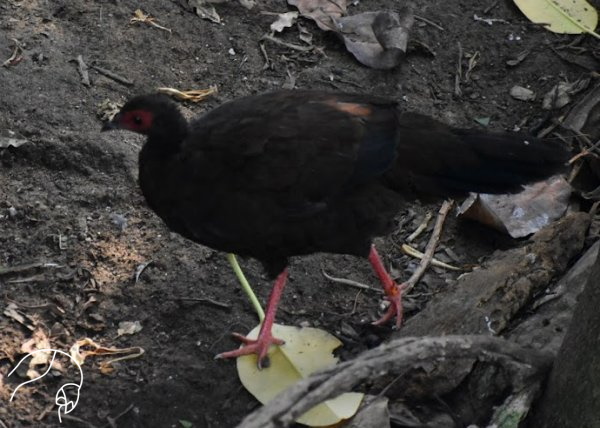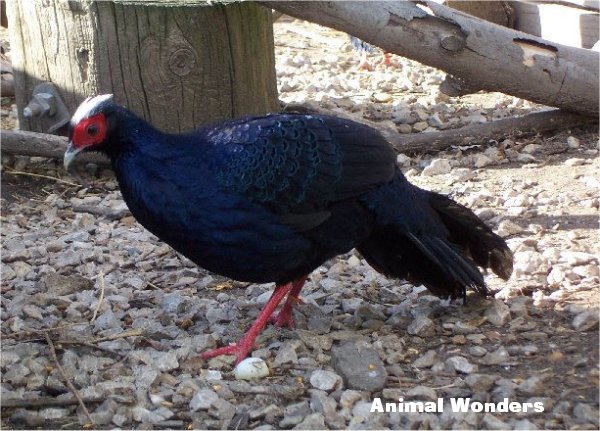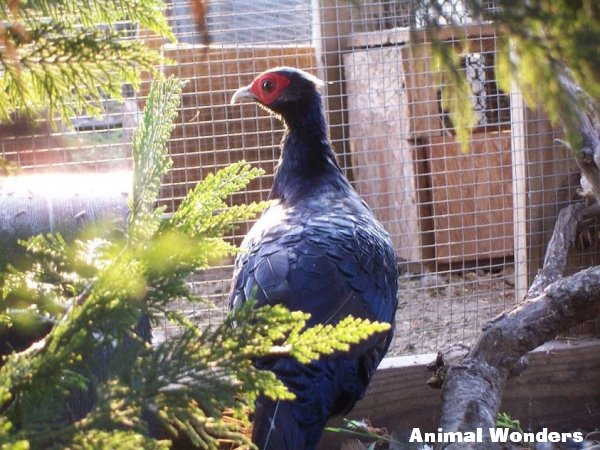Edwards's Pheasant (Lophura edwardsi)
Also known as the Vietnam Pheasant, the Edwards's Pheasant is currently isted as critically endangered in the wild. The species has a stong presence in private aviculture and zoos where captive breeding programs aim to save the Edwards's Pheasant from extinction. Animal Wonders helped to participate in the efforts, sending the pair shown in the bottom photos to the Sunset Zoo in Manhattan, Kansas.






Scientific classification: Kingdom Animalia, Phylum Chordata, Class Aves, Order Galliformes, Family: Phasianidae, Genus: Lophura, Species: Lophura edwardsi
Other Names: Annam Pheasant, Vietnam Pheasant; hatinhensis - Hatinhensis Pheasant, Vo Quy's Pheasant, Vietnamese Fireback
Range: Endemic to central Vietnam, highly fragmented.
Subspecies: Lophura edwardsi edwardsi - central tail feathers are blue, Lophura edwardsi hatinhensis - central tail feathers are white, taxonomic status still uncertain.
Habitat: Tropical forests
Status in Wild: Critically Endangered, no confirmed sightings of a wild bird since 2000. The species was believed to be extinct from the 1930s until 1996 when when a pair was found in the Phong Điền District; a male was trapped the same year in the Đa Krông District and transferred to the Hanoi Zoo. Several major wars made it very difficult for scientists to research the area during this period and the majority of its habitat was destroyed by the use of the defoliant Agent Orange by the United States during the Vietnam War. Individuals of hatinhensis were "discovered" in the 1960s in what is now the Kẻ Gỗ Nature Reserve.
Aviculture: The Edwards’s Pheasant has a stable captive population of more than a 1000 birds worldwide. Most birds are in private aviaries and there are breeding programs in place at zoos in North America, Europe, and Asia. French ornithologist Jean Delacour is often credited with bringing the founding birds in the 1920s from Vietnam to Europe in which all current captive Edwards's Pheasants are descended from. The Hanoi Zoo and the World Pheasant Association have been working on possible reintroductions when suitable habitat has been recovered.
We kept and bred this species for a number of years before sending them to a zoo breeding program. They were very gentle and curious birds, rather small and with a short tail (for a pheasant). For a tropical species, they handled the winters in Missouri quite well as long as we provided them with good shelter. They were housed with doves, finches, and parrots and caused no issue with the other species.
The courtship display of the male Edwards's Pheasant is much like others in the genus Lophura, a "wing-whirl" - the male approaches the female with his red facial wattles enlarged, white crest raised, and begins to flutter is wings back and forth at a rapid pace. He will do this several times until the female is ready to mate. I have seen Edwards's Pheasants display even when the female wasn't interested! He'd stand on his log looking at the other Lophura species in the other aviaries, doing his best dance to impress everyone.
The nest is nothing more than scrape on the ground (usually under a bush or shrub) where the female will lay 4 to 7 eggs before incubating them for about 25 days. Both parents participate in the chick rearing. It is recommended that this species is allowed to incubate and raise their own young as much as possible in captivity as this trait will be needed if our captive birds will eventually become a part of the reintroduction programs.
The captive diet of adult Edwards’s Pheasant consists of a game bird crumble or pellet - we used Purina® Game Bird Maintenance at 12.5% protein during the fall and winter months and increased the protein level to 18% in late winter to early Fall. The chow was mixed with various grains and seeds year round. Whole fruits such as apples, pears, blueberries, grapes, and sliced melons are offered every other day; leafy vegetables such as romaine, leaf, endive, kale, clover, dandelion are offered daily (some only in season); other veggies are chopped or giving whole such as soft corn, peas, broccoli, carrots, zucchini, sweet potato on days when fruit isn't offered. Live food such as mealworms, waxworms, dubia roaches, and crickets are given once a week during the spring and these are dusted with reptile calcium powder. Treats also include the occasional hard-boiled egg, millet sprays, and I admit, I've shared some of my own leftovers a time or two! Poultry grit should be available at all times. For the chicks, a high protein crumble is offered, starting at 30% and gradually decreasing with age.
Interesting Facts: Named for French zoologist Alphonse Milne-Edwards (1835-1900), who was director of the Natural History Museum in Paris and first described the bird to science in 1896.
With no confirmed sightings in more than twenty years, the Edwards's Pheasant could be completely extinct if wasn't for aviculture and zoos. Proof that these institutions benefit conservation. With habitat eventually to be restored from the destruction of the war, these birds will once again roam the forests of Vietnam and the captive breeding programs will be responsible in making this possible. Many in society want to condemn zoos and the keeping of wild animals in captivity, but here is the perfect example of how important it can be. If only we had done this with the Carolina Parakeet, Passenger Pigeon, and countless other species.
- BirdLife International Asia - Can we bring back the pheasant that was wiped out by the war in Vietnam?
- Edwards’s Pheasant - BirdLife International Factsheet
- Edwards’s Pheasant - eBird
- Faisán de Vietnam - Spanish Faisanes del mundo
- National Audubon Society - In Search of the Stunning and Possibly Extinct Edwards Pheasant
- Vietnam Pheasant - Birdorable
- Vietnam Pheasant - EAZA Best Practice Guidelines (PDF)
- Woodland Park Zoo - Rare Pheasant Hatches
- World Pheasant Association - Edwards's Pheasant from Vietnam (PDF)
External Links
The beauty and genius of a work of art may be reconceived, though its first material expression be destroyed; a vanished harmony may yet again inspire the composer, but when the last individual of a race of living things breathes no more, another heaven and another earth must pass before such a one can be again. - William Beebe, 1906
Animal Wonders
We depend on our programs & donations to help fund the care and housing for our animals, most of which are either rescues or surrenders. We seem to be always taking in new animals that need a home or different situation, their care adds up. If you would like to help support Animal Wonders, it would be greatly appreciated. We are always in need of donations, caging material, lumber, crates, aquariums, straw, & newspapers.
Contact
Animal Wonders,LLC
Address : 405 W 10th St, Holden, MO 64040
E-mail : info@animalwonders.net
Phone : 816-807-4748

